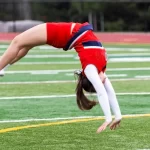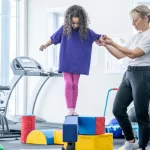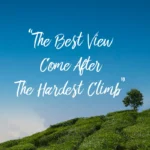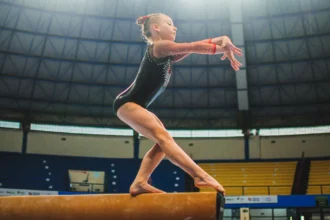Gymnast foot care is essential for maintaining performance and preventing injuries. Gymnasts rely heavily on their feet, so keeping them healthy is a top priority. Here’s how athletes keep their feet safe:
1. Taping and Padding
Taping Techniques
Taping is an integral part of a gymnast’s routine to ensure foot stability and protection.
1) Ankle Taping
This is one of the most common forms of taping used in gymnastics. It involves wrapping athletic tape around the ankle joint to limit excessive movement and provide stability.
Ankle taping helps prevent the ankle from rolling or twisting during high-impact activities and landings. This technique is especially beneficial for gymnasts who have previously suffered from ankle injuries or are prone to sprains.
2) Arch Taping
This method supports the arch of the foot, preventing it from collapsing under the intense pressure of gymnastics movements.
Arch taping can reduce the risk of plantar fasciitis, a condition caused by inflammation of the tissue connecting the heel to the toes. Supporting the arch helps maintain the foot’s structure during rigorous activities.
3) Heel Lock Taping
This technique secures the heel in place, providing additional stability during jumps and landings.
It minimizes the risk of the heel shifting, which can lead to injuries. Heel lock taping is crucial for routines involving significant impact on the feet.
4) Prewrap Tape
Prewrap tape, a foam underwrap, is often used underneath sports tape to protect the skin from irritation and chafing. It provides a barrier between the adhesive and the skin, making the taping process more comfortable and reducing the risk of skin damage when the tape is removed.
Padding for Protection
Padding is essential for cushioning and absorbing shocks from high-impact movements:
1) Foot Pads
Made from soft foam or gel, these pads are placed inside the gymnast’s shoes or directly on the feet.
They help distribute pressure evenly across the foot, reducing the likelihood of stress fractures and providing additional comfort, especially on hard surfaces or during repetitive high-impact activities.
2) Heel Cups
These specialized inserts provide extra support and cushioning to the heel. Heel cups absorb the impact of landings and jumps, reducing strain on the heel and helping to prevent conditions like plantar fasciitis.
3) Ankle Braces
Though not padding, ankle braces offer additional support and stability. Made from elastic or neoprene materials, they provide compression and help reduce the risk of sprains and other ankle injuries.
Ankle braces are particularly useful for gymnasts with a history of ankle instability.
Combining Taping and Padding:
Often, taping and padding are used together for maximum protection and support. For instance, a gymnast might put padding over a blister or high-pressure area and secure it with sports tape. This combination protects the affected area while providing necessary stability during routines.
2. Specialized Footwear
While many gymnasts prefer performing barefoot to maintain a natural feel and better control during their routines, specialized footwear plays a significant role in enhancing performance and providing necessary protection. Here are the key types of footwear and their benefits:
1) Beam Slippers
Beam slippers are designed specifically for use on the balance beam. Made from durable, tight-fitting materials like leather or microfiber, they provide excellent grip and cushioning.
The snug fit ensures the slippers stay in place during intricate movements, helping gymnasts maintain their balance and reducing the risk of slipping.
Beam slippers also protect the feet from abrasions and blisters that can occur from prolonged contact with the beam.
2) Impact Socks
Impact socks offer additional grip and protection during high-impact activities. Made from materials that provide cushioning and friction reduction, these socks help prevent blisters and other foot injuries.
The enhanced grip provided by impact socks is particularly beneficial during floor routines and on apparatuses where maintaining traction is crucial.
3) Gymnastic Shoes
Gymnastic shoes are lightweight and flexible, offering a balance between protection and the natural feel of barefoot performance.
These shoes typically have a reinforced toe area to absorb the impact of landings and protect against injuries. The soles are made from rubber or similar materials to prevent slipping while providing adequate grip on various surfaces.
4) Half Shoes
Half shoes, also known as foot thongs or toe shoes, cover the ball of the foot and toes while leaving the heel and arch exposed.
They provide support without restricting movement, help reduce friction, and protect the toes from abrasions while allowing for a natural range of motion.
5) Heel Cups and Inserts
For added support, gymnasts might use heel cups and inserts inside their shoes. Heel cups offer extra cushioning for the heel, absorbing the shock from landings and reducing strain on the heel and Achilles tendon.
Gel or foam inserts provide additional padding and support throughout the foot, helping to distribute pressure more evenly and prevent stress injuries.
6) Chalk
Though not footwear, chalk is extensively used by gymnasts to improve grip. Applied to the feet, chalk helps keep them dry, reducing slippage and enhancing stability on apparatuses like the balance beam and during floor routines.
It’s an essential tool for maintaining control and preventing falls, especially in high-pressure competitive settings.
3. Proper Technique and Conditioning
Maintaining good technique and doing specific exercises are vital for gymnasts to keep their feet and legs safe from injury. Here’s how these practices help with foot care:
1) Landing Technique
Proper landing techniques are essential to reduce impact on the feet and legs. Gymnasts learn to land with their feet hip-width apart, knees bent, and hips aligned to spread the force of impact over a larger area.
This lessens the strain on any single part of the foot and helps prevent injuries like stress fractures and ligament sprains.
Key Points:
- Land with feet parallel and hip-width apart.
- Bend the knees to absorb shock.
- Keep the torso upright to distribute force evenly
2) Take-Off Technique
The technique used to push off from the floor or apparatus is equally important. Proper take-off technique involves using the entire foot, starting from the heel, rolling through the arch, and pushing off with the toes.
This ensures that the force is evenly distributed and reduces the risk of overuse injuries.
Key Points:
- Use a smooth roll from heel to toe.
- Engage the arch of the foot for a strong push-off.
- Ensure even weight distribution across the foot
3) Foot Positioning
Maintaining proper foot positioning during routines helps in preventing unnecessary strain and potential injuries. For instance, during spins and turns, gymnasts should align their feet correctly to avoid twisting injuries.
Key Points:
- Keep feet aligned with the knees and hips.
- Avoid excessive twisting or bending of the ankles.
- Use proper alignment to enhance stability and control
4) Strengthening Exercises
Regular foot and ankle strengthening exercises boost muscle strength and offer better joint support. These exercises build the strength needed to handle repetitive high-impact activities.
Examples:
- Heel Raises: Strengthens the calf muscles and improves ankle stability.
- Toe Walking: Enhances the strength of the intrinsic foot muscles and improves balance.
- Resistance Band Workouts: Strengthen the muscles around the ankle and improve flexibility
5) Flexibility Exercises
Flexibility is essential for gymnasts to perform a wide range of movements without injuring their feet. Stretching exercises targeting the feet and ankles can prevent stiffness and improve range of motion.
Examples:
- Calf Stretches: Prevent tightness in the calf muscles, which can affect foot mobility.
- Toe Stretches: Enhance flexibility in the toes, crucial for maintaining balance and executing precise movements.
- Ankle Circles: Improve the flexibility of the ankle joint, reducing the risk of sprains
4. Using Varied Surfaces
Different surfaces offer different levels of impact absorption and grip, which can help condition the feet to handle various types of stress.
1) Spring Floors
Gymnastics facilities often use spring floors because they provide extra bounce and reduce foot impact during landings.
Training on these floors helps build explosive power and lowers the risk of joint and foot injuries.
2) Foam Pits and Soft Mats
Using foam pits or soft mats for practicing new and risky moves allows gymnasts to land safely while perfecting their technique.
These cushioned surfaces reduce the chance of foot and ankle injuries during the learning phase.
3) Hard Floors
Occasionally training on harder surfaces helps gymnasts adapt to the conditions they might encounter in competitions.
This strengthens the feet and ankles, preparing them to handle the shock of landing on less forgiving surfaces.
4) Outdoor and Uneven Surfaces
Exercising on grass, sand, or uneven terrain improves proprioception and foot strength. These surfaces challenge the stabilizing muscles in the feet and ankles, enhancing their ability to adapt to different challenges.
Importance of Surface Rotation:
Switching between different surfaces during training helps prevent overuse injuries. Constantly training on hard surfaces can cause stress injuries from repetitive high impact.
By varying the surfaces, gymnasts reduce repetitive strain on specific parts of their feet, allowing for better recovery and adaptation.













